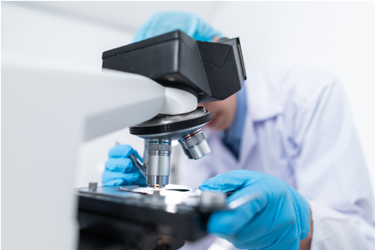AFM Or Electron Microscopy: A Battle Of Imaging Titans

By John Oncea, Editor

Atomic Force Microscopy and Electron Microscopy cater to diverse scientific and industrial applications. Understanding their advantages and limitations is essential for selecting the appropriate technique.
In nanoscale imaging, two techniques stand out: Atomic Force Microscopy (AFM) and Electron Microscopy (EM). Both have revolutionized fields from materials science to biomedical research, but they serve different purposes and offer distinct advantages. Understanding when to use AFM over EM—and vice versa—is crucial for researchers looking to capture the most detailed and meaningful data.
AFM operates by scanning a sharp probe across a surface, measuring forces between the tip and the sample to construct an image. According to Oxford Instruments, “AFM gathers information by ‘feeling’ a surface, much like a finger does but at a much smaller scale. It uses a tiny probe, with a very sharp tip, to sense small variations in force. This simple but clever idea was invented in the early 1980s and won a Nobel prize in 1986.”
EM, on the other hand, uses beams of electrons instead of light to generate images. There are two main types of electron microscopes – the transmission EM (TEM) and the scanning EM (SEM). “A transmission electron microscope produces an image by passing a high voltage electron beam through a very thin specimen that is semi-transparent to electrons,” writes News-Medical.Net. “The beam that is transmitted through the specimen carries structural information about the specimen, which can then be magnified by the microscope. By contrast, a scanning electron microscope detects secondary electrons that arise from the surface as a result of excitation by the original electron beam.”
The decision between AFM and EM ultimately depends on the research question at hand. If studying mechanical properties or nanoscale topography in a natural environment, AFM is the go-to technique. However, when internal structures, high-throughput imaging, or elemental analysis are needed, EM is the better option. Researchers in many advanced labs leverage both techniques, combining their strengths for a more complete understanding of nanoscale systems.
Advantages And Limitations Of Both
AFM allows for imaging in various environments, including air and liquids, enabling the study of biological macromolecules and living organisms without extensive sample preparation. Beyond topographical imaging, AFM can assess mechanical, electrical, and magnetic properties at the nanoscale, providing comprehensive data about the sample.
It can measure physical properties such as stiffness, adhesion, and conductivity at the nanoscale, as well as provide true 3D surface profiles, offering precise measurements of surface roughness and morphology, which is advantageous in materials science and nanotechnology research.
In addition, AFM does not require conductive coatings or vacuum conditions, preserving the sample’s integrity and allowing for repeated measurements over time.
In contrast, SEM scans the sample’s surface with a focused electron beam, producing detailed images of surface topography and composition while TEM transmits electrons through thin samples, revealing internal structures with atomic-scale resolution.
TEM achieves atomic-scale resolution, allowing for detailed visualization of internal structures, which is essential in fields like materials science and virology. SEM can quickly scan large areas, facilitating high-throughput analysis, which is beneficial in quality control and industrial applications.
EM techniques can be equipped with detectors for elemental analysis, enabling the determination of chemical composition alongside structural imaging.
On the downside, AFM typically images areas up to 150×150 micrometers, which may not be sufficient for samples requiring larger field-of-view analysis. Scans are relatively slow, often taking several minutes per image, which can be a limitation for dynamic processes or high-throughput requirements. Finally, AFM is sensitive to surface contaminants, necessitating meticulous sample preparation to obtain accurate results.
EM requires vacuum conditions, which can be incompatible with certain biological samples and may necessitate extensive sample preparation. Non-conductive samples often need to be coated with conductive materials potentially altering or damaging delicate structures and the high-energy electron beam in EM can cause radiation damage, especially in beam-sensitive materials, limiting its use for certain applications.
Recent Developments And Considerations
Advancements in both AFM and EM technologies continue to expand their capabilities and applications. Recent studies have highlighted the complementary nature of these techniques, suggesting that integrating AFM and EM can provide a more comprehensive understanding of nanoscale materials.
For instance, combining AFM’s ability to measure surface physical properties with EM’s capacity for chemical composition analysis allows for a more holistic characterization of samples. This integrated approach is particularly beneficial in fields like materials science, where understanding both structural and compositional aspects is crucial.
Moreover, ongoing improvements in AFM’s scanning speed and imaging range aim to address its current limitations, making it more competitive with EM in terms of throughput and field-of-view. Similarly, developments in EM, such as environmental SEM (ESEM), are working toward mitigating issues related to vacuum requirements and sample conductivity, broadening the scope of samples that can be analyzed without extensive preparation.
The Choice Is Yours
Determining whether AFM or EM is better suited for a particular application depends on various factors, including the nature of the sample, the specific information sought, and the practical constraints of the analysis. AFM excels in providing three-dimensional surface profiles and measuring mechanical properties in ambient or liquid environments, making it ideal for studying biological samples and soft materials. In contrast, EM offers higher-resolution imaging and rapid scanning capabilities, which are advantageous for analyzing internal structures and performing elemental analysis.
In many cases, employing both techniques in a complementary manner yields the most comprehensive insights, leveraging the strengths of each to overcome their limitations. As technological advancements continue to enhance the capabilities of both AFM and EM, their combined application will undoubtedly play a pivotal role in the ongoing exploration and understanding of the nanoscale world.
While AFM and EM each have their unique advantages, they are not competitors so much as complementary tools in the imaging arsenal. As advancements continue – such as high-speed AFM and AI-enhanced EM – the future of nanoscale imaging will likely involve seamless integration of both, unlocking even greater discoveries in science and technology.
